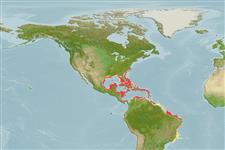Environment: milieu / climate zone / profondeur / distribution range
Écologie
marin récifal; profondeur 6 - 73 m (Ref. 9710). Tropical
Western Atlantic: Bahamas, off Belize, Colombia, Bermuda, Puerto Rico, Antigua, Tortugas and off the Atlantic coast of Florida.
Taille / Poids / Âge
Maturité: Lm ? range ? - ? cm
Max length : 6.3 cm TL mâle / non sexé; (Ref. 7251)
Description synthétique
Clés d'identification | Morphologie | Morphométrie
Pair of elongate fleshy tabs near tip of 2nd dorsal spine. Only one with the illicium shorter than 2nd dorsal spine.
Body shape (shape guide): short and / or deep.
Occurs mainly near patches of reef and rock. Relatively uncommon (Ref. 9710). Smallest frogfish in the western Atlantic (Ref. 26938).
Life cycle and mating behavior
Maturité | Reproduction | Frai | Œufs | Fécondité | Larves
Oviparous.
Robins, C.R. and G.C. Ray, 1986. A field guide to Atlantic coast fishes of North America. Houghton Mifflin Company, Boston, U.S.A. 354 p. (Ref. 7251)
Statut dans la liste rouge de l'IUCN (Ref. 130435: Version 2025-1)
Menace pour l'homme
Harmless
Utilisations par l'homme
Pêcheries: pêcheries vivrières
Outils
Articles particuliers
Télécharger en XML
Sources Internet
Estimates based on models
Preferred temperature (Réf.
123201): 23.7 - 28, mean 26.6 °C (based on 288 cells).
Phylogenetic diversity index (Réf.
82804): PD
50 = 0.5002 [Uniqueness, from 0.5 = low to 2.0 = high].
Bayesian length-weight: a=0.02630 (0.01029 - 0.06725), b=2.96 (2.73 - 3.19), in cm total length, based on LWR estimates for this (Sub)family-body shape (Ref.
93245).
Niveau trophique (Réf.
69278): 3.6 ±0.6 se; based on size and trophs of closest relatives
Résilience (Réf.
120179): Haut, temps minimum de doublement de population inférieur à 15 mois (Fec assumed to be > 10,000).
Fishing Vulnerability (Ref.
59153): Low vulnerability (10 of 100).
🛈
Nutrients (Ref.
124155): Calcium = 95.2 [39.0, 191.4] mg/100g; Iron = 0.713 [0.344, 1.429] mg/100g; Protein = 18.4 [15.8, 21.7] %; Omega3 = 0.144 [0.048, 0.383] g/100g; Selenium = 19.2 [6.9, 53.5] μg/100g; VitaminA = 418 [88, 1,966] μg/100g; Zinc = 1.41 [0.82, 2.40] mg/100g (wet weight);
